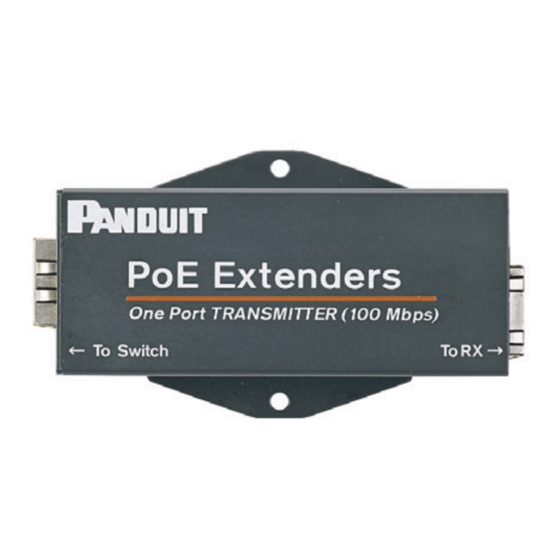
Advertisement
Quick Links
Application Guide
Panduit Power over Ethernet Extenders Application Guide
Introduction
The Panduit Power over Ethernet (PoE) extenders provide the most cost-effective and reliable method to extend data
and power at lengths up to 2,000 feet using standard off-the-shelf 4-pair copper cabling. The goal of this document is to
provide application instructions for these PoE extenders. This includes:
● Overview of the offering
● Length and power guidelines
● Physical deployment recommendations
● Frequently asked questions
● Part Selection Guide
PoE Extender Product Overview
System Overview
The PoE Extenders can operate at either 10 Mb/s or 100 Mb/s. Both the switch and end device must be capable at
operating at these speeds and both must operate at the same 10 Mb/s or 100 Mb/s speed.
To extend power and data beyond 100 meters, each link will require (1) transmitter and (1) receiver. There is only one type
of transmitter, but two types of receivers: a 1-port and 4-port. An exemplary deployment is shown in Figure 1.
The system does require power, either through a Power over Ethernet enabled switch or at least one external power
supply. The amount of power needed is dependent on the amount of power needed by the end device attached to the
receiver. This is detailed in the next section.
Transmitter
Receivers
Figure 1: Panduit PoE Transmitter and Receivers, as well as an exemplary deployment example for both the 1-port and 4-port receivers.
1-port Option
4-port Option
Up to 610m/
2000 ft. UTP
Optional
Power Supply
Up to 610m/
2000 ft. UTP
Optional
Power Supply
Advertisement

Summary of Contents for Panduit POEXTX1
- Page 1 Up to 610m/ 2000 ft. UTP Optional Power Supply 4-port Option Up to 610m/ 2000 ft. UTP Optional Power Supply Figure 1: Panduit PoE Transmitter and Receivers, as well as an exemplary deployment example for both the 1-port and 4-port receivers.
- Page 2 More power will be available with a 50 W power. If only data transmission is needed, a PoE compatible 802.3af class 2-port (providing up to 6.49 W) is required. If an external power supply is used, Panduit recommends the 60 W power supply (POWER-60W, sold separately) for use with this device.
- Page 3 PoE Extenders, 4-port Receiver Box (POEXRX4) continued If an external power supply is used, Panduit recommends the 110 W power supply (POWER-110W, sold separately or as part of the POEXKIT4 and POEXKIT4-NP) for use with this device. This should be done in cases where the transmitter was unable to provide sufficient power to the receiver for use by the end devices.
- Page 4 PD” must be split amongst the four ports, offering a lower total power available per port As can be seen from the tables, for example, with a 30 W PoE Switch, Panduit can supply up to 12.95 W at 2000 feet with 23 AWG or 24 AWG cables.
- Page 5 PD” must be split amongst the four ports, offering a lower total power available per port As can be seen from the table, for example, Panduit can only supply up to 25.5 W at 1,263 feet with 23 AWG cable.
- Page 6 Table 4: 1-port (POEXRX1) Receiver Box powered by a 60 W External Power Supply (such as POWER-60W) (assuming 55VDC output) or a 4-port (POEXRX4) Receiver Box powered by a 110 W External Power Supply (such as POWER-110W). A PoE Switch or additional external power supply (such as POWER-60W) is attached to the Transmitter Box (POEXTX1).
- Page 7 Recommended Deployment Key Questions to Answer on Deployment Panduit recommends understanding the following elements when determining how to deploy the PoE extenders. Can the switch and powered devices both run at the same speed, either 10 Mb/s or 100 Mb/s? Refer to the instructions or specifications for both the switch and the powered device for the data rate at which they can operate.
- Page 8 Location of Devices Transmitters (POEXTX1) Panduit recommends placing the transmitters (POEXTX1) near the switch. The ideal deployment would be to place the transmitters in the panels (POEXPANEL-BL and POEXPANEL-WH) which are designed to mount in the rack. These can then be patched using a short patch cord as shown in Figure 5.
- Page 9 Question: How do I provide lightning protection with this device? Answer: To prevent damaging networking equipment, Panduit recommends using the guidance of Article 800 of the NEC. The article recommends using a UL 497 Listed primary protector for all conductive communications paths entering or leaving a building as close as possible to the cable’s point of entrance.
- Page 10 ● Use POWER-190W when using the POEXPANEL; this can power up to (4) 1-port transmitters or receivers and mounts to the panel Refer to Table 5 for a list of the Panduit PoE Extender Parts and Kits and Table 6 for Panduit PoE Extender Accessories.
- Page 11 Power cord sold separately – for use outside of North America. POEXKIT4-NP PoE extender kit (1) transmitter, (1) 4-port receiver, one power supply. Power cord sold separately – for use outside of North America. Table 5: Panduit PoE Extender Parts and Kits...
- Page 12 THE INFORMATION CONTAINED IN THIS APPLICATION GUIDE IS INTENDED AS A GUIDE FOR USE BY PERSONS HAVING TECHNICAL SKILL AT THEIR OWN DISCRETION AND RISK. BEFORE USING ANY PANDUIT PRODUCT, THE BUYER MUST DETERMINE THE SUITABILITY OF THE PRODUCT FOR HIS/HER INTENDED USE AND BUYER ASSUMES ALL RISK AND LIABILITY WHATSOEVER IN CONNECTION THEREWITH.

Need help?
Do you have a question about the POEXTX1 and is the answer not in the manual?
Questions and answers